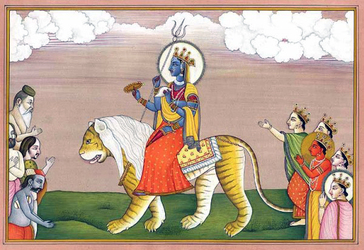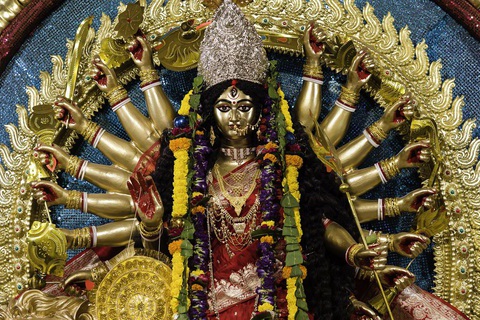Navaratri: history and traditions
Thousands of Hindus consider Navaratri to be the most important holiday, and this has a profound meaning. Nine days of Navaratri are dedicated to the female hypostasis of God, the Mother Goddess: the feast is held in order to receive Her blessings and to try to reveal one's divine nature. Navaratri is the time for spiritual conversations, asceticism, selfless deeds, and prayers. Navaratri is a holiday not only for women: everyone can participate in divine services, festivals, performances, and dances; everyone can worship God in the image of a loving Mother, who gives life.

There is a tradition to plant grains in clay pots on the first day of Navaratri, so that they sprout during all the nine days of the holiday. In some regions of India, women are preparing a specially decorated vessel representing the Goddess and symbolizing fertility. In the state of Tamil Nadu create special shelves called "kolu", on which every year a clay doll made by one's own hands is put. This collection is constantly replenished and passed on from generation to generation.
It is difficult to say exactly how many years the tradition of celebrating Navaratri has. According to some reports, it comes from an ancient festival of harvest and fertility. Unequivocally, the worshipping of the female aspect of divine energy goes as far as the written and other sources, as far as the memory of the mankind allows to trace.
In India it is believed that the Vedas are the most ancient books on the planet. It is known that they are at least 8000 years old, but already in their hymns and prayers they glorify the female images of the divine power.
But only in the time of creation of the Puranas, the female hypostasis of God, the Mother Goddess was begun to be treated as a force opposing evil, and nine days of Navaratri began to be singled out separately. The Puranas are a collection of eighteen Hindu religious writings, written between 400 and 1000 BC. They are containing stories of the creation, destruction, and reconstruction of the Universe, the genealogy of kings and gods, and a number of parables.
The most ancient Hindu religious texts, that describe the struggle between good and evil and report the celebration of Navaratri, are the Ramayana and Chandi Path (Durga Saptashati).
The text that most fully describes the Divine Mother and reveals the reasons for Navaratri celebration is Chandi Path, which is the Purana text, a part of the Markandeya Purana. Chandi Path refers to approximately 900-500 years BC, but probably it took its modern appearance during the 4th century AD, when emperors of the Gupta empire obliged scientists to collect, edit, and record oral traditions of prose and poetry. Since the oral transmission of knowledge was broadly practiced in India, the roots of Chandi Path may go to even a more ancient time.
Judging by the second text, the epic of the Ramayana, the history of Navaratri is much older, since it is believedб that the Ramayana was written before the appearing of Chandi Path. Some astronomers and scholars claim, that the story of Prince Rama, the hero of the epic, took place in the fifth millennium BC; and before the battle with the demon Ravana, prince Rama prayed to the Mother Goddess during several days of the Navaratri period. If so, then the practice of celebrating Navaratri is about 8,000 years old.
Be that as it may, the Ramayana, just as Chandi Path, is a story, in which good conquers evil. If the story of the victory of the goddess Durga over the demon Mahishasura, described in Chandi Path, is more mythological and symbolic, then Rama's story is considered real. Hindus believe: when humanity is in trouble, God incarnates in a human body to help people to overcome evil forces and to give an example of a righteous life. Rama was one of these incarnations. Symbolically, the Ramayana, as well as the legend of Durga, is interpreted as the victory of light over darkness, good over evil.
See also:

Navaratri - a holiday dedicated to the feminine aspect of divine energy
Navratri (Navaratri) is an Indian holiday, which takes place over nine nights during spring and autumn. Literally translated from Sanskrit Navratri means "nine nights".

Autumn Navaratri. How Maha Navmi is celebrated in different regions of India
Sharad (shardia), or Autumn Navratri, is the most important of the two Navratris. It is called Maha Navratri (Great Navratri) and is celebrated in September-October according to the Gregorian calendar, during the onset of cold weather. Since the dates of celebration are calculated by the lunar and solar cycles, they are shifted from year to year.

 RU
RU IND
IND